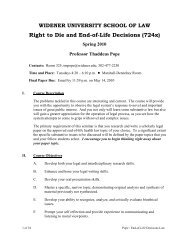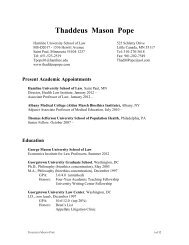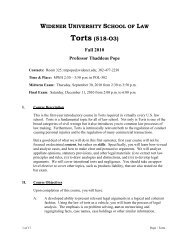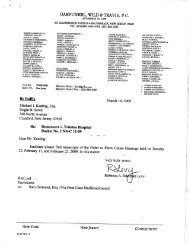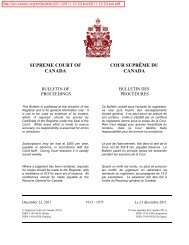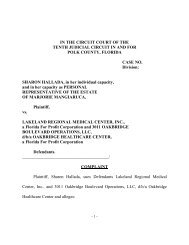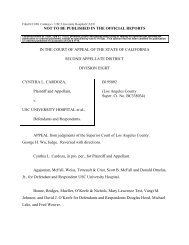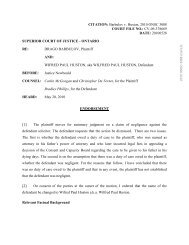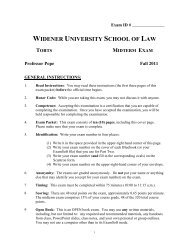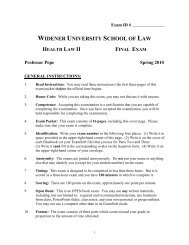Midterm Exam - Thaddeus Pope
Midterm Exam - Thaddeus Pope
Midterm Exam - Thaddeus Pope
Create successful ePaper yourself
Turn your PDF publications into a flip-book with our unique Google optimized e-Paper software.
Take Home <strong>Midterm</strong> <strong>Exam</strong>ination Hamline University School of Law 2013 Spring SemesterInstructor : Professor <strong>Thaddeus</strong> <strong>Pope</strong>Course Title : Bioethics & LawSection : Law 9558, Section 1Format : Take HomeTotal Time for <strong>Exam</strong> : 48 hoursTotal Number of Pages : 12 PagesReference Materials AllowedOpen Book (all reference materials allowed)Take-Home <strong>Exam</strong> Instructions<strong>Exam</strong> Number __ __ __ __ __1. Please know your correct Spring 2013 exam number and include this number at the top of each page of yourexam answer (for example, in a header). To locate your exam number, go to www.hamline.edu and follow thesteps below. A graphic guide to locating your exam number is attached to these instructions.Click on Logins in the header.Go to PiperlineLog in to the secure areaEnter your Student ID and PINClick Student ServicesClick RegistrationClick Student Detail ScheduleSelect the appropriate term from the drop down menu<strong>Exam</strong> Numbers are listed below Total Credit Hours at the top of the page2. Confirm that you are using and have typed the correct exam number on your exam document.3. You may download the exam from the course TWEN site any time after 4:00 p.m. on Sunday, February 24, 2013.All exams must be submitted within 48 hours of download. But, in any case, all exams must be submitted by theend of the midterm exam period, i.e. by 11:00 p.m. on Saturday, March 2, 2013. Therefore, you will want todownload your exam no later than 11:00 p.m. on Thursday, February 28, 2013, to ensure that you have the fullallowed 48 hours to complete your exam.4. Write your answers to BOTH parts of the exam in a word processor. Save your document as a single PDF filebefore uploading to TWEN. Use your exam number as the name for the PDF file.Instructions Specific to This <strong>Exam</strong>inationGENERAL INSTRUCTIONS:1. Honor Code: While you are taking this exam, you are subject to the Hamline University Code of Conduct. Youmay not discuss it with anyone until after the end of the entire exam period. It is a violation of the Honor Codeto share the exam questions. Shred or delete the exam questions immediately upon completion of the exam.They will be reposted after the end of the exam period.2. Competence: Accepting this examination is a certification that you are capable of completing the examination.Once you have accepted the examination, you will be held responsible for completing the examination.Page 1 of 12
Take Home <strong>Midterm</strong> <strong>Exam</strong>ination Hamline University School of Law 2013 Spring Semester3. <strong>Exam</strong> Packet: This exam consists of 12 pages, including this cover page but excluding the appendix of graphicson getting an exam number and submitting on TWEN. Please make sure that your exam is complete.4. Identification: Write your exam number on the top of each page of your exam answer.5. Anonymity: The exams are graded anonymously. Do not put your name or anything else that may identify you(except for your exam number) on the exam. Failure to include your correct exam number will result in a 10-point deduction.6. Total Time: Your completed exam is due within 48 hours of downloading it. If your exam is uploaded more than48 hours after downloading the exam, your exam grade will be lowered by one point for every minute in excessof the 48 hours. If the timestamp on your uploaded exam indicates that you have exceeded the 48-hout limit bymore than 15 minutes, the situation may be referred for a Code of Conduct investigation and potentialdiscipline. Please save sufficient time to successfully upload your exam.7. Timing: The exam has been written as a two-hour exam. A student could write basically complete answers toall the questions in two hours. But since this is a take-home exam, you will want to take some extra time(perhaps two hours) to outline your answers and consult your course materials. You will also want to take someextra time (perhaps two hours) to revise and polish your answers, such that you will not be submitting a “firstdraft.” In short, while this is a 48-hour take home, you really need not spend more than four hours on thisexam.8. Scoring: There are 75 total points on the exam. The final exam comprises 25% of your overall course grade, 75of the 300 total course points.9. Open Book: This is an OPEN book exam. You may use any written materials, including, but not limited to: anyrequired and recommended materials, any handouts from class, PowerPoint slides, class notes, and your ownpersonal or group outlines.10. Additional Research: While you may use any materials that you have collected for this class, you are neitherexpected nor are you permitted to do any online or library research (e.g. on Lexis, Westlaw, Google, Bing,reference materials) to answer the exam questions.11. Format: The exam consists of two parts:PART ONE comprises 30 multiple choice questions worth 1 point each, for a combined total of 30 points.PART TWO comprises three short essay questions worth a combined total of 45 points.12. Grading: All exams will receive a raw score from zero to 75. The raw score is meaningful only relative to theraw score of other students in the class. Your semester course letter grade is computed by summing themidterm, final, and quiz scores. I will post an explanatory memo and a model answer to TWEN a few weeksafter the exam.SPECIAL INSTRUCTIONS FOR PART ONE:1. Numbered List of Letters: In your exam document create a vertical numbered list (1 to 30). Next to eachnumber type the letter corresponding to the best answer choice for that problem.2. Ambiguity: If (and only if) you believe the question is ambiguous, such that there is not one obviously bestanswer, neatly explain why immediately after your answer choice. Your objection must (i) identify the ambiguityor problem in the question and (ii) reveal what your answer would be for all possible resolutions of theambiguity. I do not expect this to be necessary.Page 2 of 12
Take Home <strong>Midterm</strong> <strong>Exam</strong>ination Hamline University School of Law 2013 Spring SemesterSPECIAL INSTRUCTIONS FOR PART TWO:1. Submission: In your exam document create clearly marked separate sections for each of the three problems:Short Answer 1Short Answer 2Short Answer 32. Outlining Your Answer: I strongly encourage you to use at least one-fourth of the allotted time per question tooutline your answers on scrap paper before beginning to write. Do this because you will be graded not only onthe substance of your answer but also on its clarity and conciseness. In other words, organization, precision,and brevity count. If you run out of insightful things to say about the issues raised by the exam question, stopwriting until you think of something. Tedious repetition, regurgitations of law unrelated to the facts, or ramblingabout irrelevant issues will negatively affect your grade.3. Answer Format: This is important. Use headings and subheadings. Use short single-idea paragraphs (leaving ablank line between paragraphs). Do not completely fill the page with text. Leave white space both betweensections and paragraphs.4. Answer Content: Address all relevant issues that arise from and are implicated by the fact pattern and that areresponsive to the “call” of the question. Do not just summarize all the facts or all the legal principles relevant toan issue. Instead, apply the law you see relevant to the facts you see relevant. Take the issues that you identifyand organize them into a coherent structure. Then, within that structure, examine issues and argue for aconclusion.5. Citing Cases: You are welcome but not required to cite cases. While it is sometimes helpful to the reader and away to economize on words, do not cite case names as a complete substitute for legal analysis. For example, donot write: “Plaintiff should be able to recover under A v. B.” Why? What is the rule in that case? What are thefacts in the instant case that satisfy that rule?6. Cross-Referencing: You may reference your own previous analysis (e.g. B’s claim against C is identical to A’sclaim against C, because __.” But be very clear and precise what you are referencing. As in contractinterpretation, ambiguity is construed against the drafter.7. Balanced Argument: Facts rarely perfectly fit rules of law. So, recognize the key weaknesses in your positionand make the argument on the other side.8. Additional Facts: If you think that an exam question fairly raises an issue but cannot be answered withoutadditional facts, state clearly those facts (reasonably implied by, suggested by, or at least consistent with, thefact pattern) that you believe to be necessary to answer the question. Do not invent facts out of whole cloth.<strong>Exam</strong> MisconductThe Code of Conduct prohibits dishonest acts in an examination setting. Unless specifically permitted by the exam orproctor, prohibited conduct includes:● Discussing the exam with another student● Giving, receiving, or soliciting aid● Referencing unauthorized materials● Reading the questions before the examination starts● Exceeding the examination time limit● Ignoring proctor instructionsPage 3 of 12
Take Home <strong>Midterm</strong> <strong>Exam</strong>ination Hamline University School of Law 2013 Spring Semester5. Christy plans to track the restrictions that U.S. immigration laws imposed on certain ethnic groups.She plans to do this by reviewing passenger lists from ships that transported immigrants to Americabetween 1840 and 1860. This study would be categorized as:A. Expedited ReviewB. Exempt ReviewC. Full Board ReviewD. Not Human Subjects Research6. When can research with children be “exempt”?A. When children are 12 years old or olderB. It can never be exempt.C. When parents request an exemptionD. When it falls into an eligible category of research activity7. An investigator proposes a study to determine the clinical relevance of a therapy for teenaged (age13 to 17) patients undergoing chemotherapy. The study requires that three additional bone marrowsamples be taken during the course of chemotherapy. The subject's chemotherapy will not bealtered based on the results of the measures. However, future patients with cancer would benefitfrom improved interventions based on the study’s findings. The IRB has determined that the studyentails a minor increase over minimal risk. Which of the following statements best describes the IRBapproval requirements for involving children in the study?A. Assent is not required, but one parent must give permissionB. Assent is not required, but both parents must give permissionC. Both assent of the child and permission of both parents are requiredD. Only assent of the child is requiredUSE THIS FACT PATTERN FOR BOTH QUESTIONS 8 AND 9Alice is planning federally funded research study involving children who are 7 to 11 years old. Alice’sresearch involves collecting two urine samples from healthy children to measure amounts of protein.Alice’s IRB has determined that assent of children age 9 and older is required for the study. One 11-year-oldrefuses assent to participate in the study described above.8. Which of the following procedures best describes the required action?A. Consent one of the child’s parents insteadB. Request the child to reconsider assenting to the studyC. Honor the child’s decisionD. Consent both of the child’s parents insteadPage 5 of 12
Take Home <strong>Midterm</strong> <strong>Exam</strong>ination Hamline University School of Law 2013 Spring Semester9. Under the Common Rule, the IRB’s risk assessment for this study is probably:A. More than minimal risk with prospect of direct benefit to the childB. No more than minimal risk to the childC. More than minimal risk with no prospect of direct benefit to the childD. No risk to the child and no further IRB review is requiredUSE THIS FACT PATTERN FOR BOTH QUESTIONS 10 AND 11A Full IRB Committee meeting is convened on February 22, 2013. The IRB Committee roster consists of 17members. However, only 9 members are in attendance at today's meeting. One of the protocols to bereviewed at this meeting is new research proposing to evaluate how mothers interact with their learningdisabled children.10. Which of the following IRB members must be present during the IRB's discussion and vote on thisproposal?A. The Principal Investigator for the research proposal under deliberationB. A member who is unaffiliated with the institutionC. The non-scientist memberD. A social worker11. The protocol requires that the children in the study be at least six years old. The protocol requiresthe mother of the child (a) to look at the child without any expression and (b) not to talk to the childfor four minutes. One of the IRB members, Frank, is Principal Investigator for the study and receivesa portion of his salary from the supporting grant. Frank, the principal investigator, must recusehimself from the IRB room during both the final deliberations and the vote on the study.Which of the following best describes the IRB's action after Frank leaves?A. Trust that the study is ethical because Frank is a member of the Committee. Continue with thefinal deliberations and vote.B. Use an expert in child development as a consulting reviewer to help answerquestions in Frank’s absenceC. Defer the proposal to the next meeting because there is no quorumD. Continue with review, discussion and vote because the minutes will note that Frankabstained from the vote12. A researcher began a records-based research project. But this researcher later determined that theindividuals whose data is being collected must be contacted, to get updated health information. Thiswill require a change to the protocol. What level of IRB review is most likely?A. NoneB. Expedited ReviewC. Review for ExemptionD. Full Board ReviewPage 6 of 12
Take Home <strong>Midterm</strong> <strong>Exam</strong>ination Hamline University School of Law 2013 Spring Semester13. The death of Ellen Roche exposed the following problems with research at Johns Hopkins?A. There were not sufficient IRB resources relative to the number of research protocolsB. Failure to respond adequately to a previous adverse eventC. Both A and BD. Neither A nor B14. Under the Common Rule, “private” information:A. Includes information about behavior, but not existing recordsB. Includes information about behavior and existing recordsC. Excludes any behaviors that can be observedD. Can be identified in accordance with universal standards15. Brendan is a researcher who wants to investigate regional birth rates. He plans to review publicbirth records that are available at county court-houses.A. This is human subject researchB. This is NOT human subject research16. Kelly is a cognitive psychologist. He proposes to recruit undergraduate students for a computerbasedstudy about the effect of mood states on problem-solving performance.A. This is human subject researchB. This is NOT human subject research17. Milo is a developmental psychologist. He proposes videotaping interactions between pre-schoolchildren and their caregivers in a laboratory setting to determine what methods of communicationmost effectively manage aggression.A. This is human subject researchB. This is NOT human subject research18. When reviewing federally supported research involving prisoners, an IRB must include the followingmember(s), in addition to the standard requirements for IRBs, to ensure that the prisoners’perspective is represented:A. Two members who are currently prison guards, wardens or parole officersB. Two members who are employed by the penal systemC. One member who is a prisoner or prisoner representativeD. One member who is a health care provider at the local hospital where prisoners maybe treatedPage 7 of 12
Take Home <strong>Midterm</strong> <strong>Exam</strong>ination Hamline University School of Law 2013 Spring Semester19. Jordan has prepared a federally supported research protocol. Her goal is to examine thecharacteristics and effectiveness of “house arrest,” a program where individuals are confined to theirhomes under continuous surveillance (e.g. with an electronic ankle bracelet). Which of the followingbest describes the IRB’s duties when reviewing this research?A. Even though this research involves individual subjects who would be considered prisoners andexamines an alternative to incarceration, the IRB does not have any additional dutiesB. Since this research involves individual subjects who would be considered prisoners andexamines an alternative to incarceration, the IRB should ensure that the additionalrequirements for prisoner research are metC. Since this research is federally supported, the IRB does not have any duty to reviewthis researchD. Since this research does not involve individual subjects who would be consideredprisoners, the IRB does not have any additional duties20 Which of the following studies meets the definition of “research” with human subjects?A. A study in four 3 rd grade classrooms about the relationship between the time of dayreading is taught and improved reading comprehension.B. The collection of data about the physical dimensions of public school playgrounds by acontracted playground designerC. An analysis of Minnesota Department of Education aggregate data comparing statewide publichigh school graduation ratesD. None of the above21. The Nuremberg Code:A. Had an immediate and profound influence on how research was conducted in theUnited StatesB. Resulted in the establishment of the OHRPC. Was not considered relevant to research practices in the United States22. As defined in the Belmont Report, the ethical principle of respect for person relates tothe general rule:A. Obtain consent from subjectsB. Maximize possible benefits and minimize potential risksC. The burdens of research should be shared equallyD. Children should not be enrolled in researchPage 8 of 12
Take Home <strong>Midterm</strong> <strong>Exam</strong>ination Hamline University School of Law 2013 Spring Semester23. Which of the following is NOT required on an informed consent form?A. A contact person for questions about the researchB. The purpose of the researchC. A description of benefits that may be reasonably expected from the researchD. A statement that participation is voluntaryE. A list of all personnel who will be involved in the research24. Derek wants to compare the effect of print media versus electronic social media on individuals'opinions on several social issues. Derek’s girlfriend is the warden of a local work release facility. Shewill allow Derek access to the prison population to help her recruit subjects. Derek will also recruitsubjects on his college campus. The study takes just 20 minutes. The risks appear to be no morethan minimal. The IRB would most likely:A. Approve this project, because the warden is the ultimate authority on whathappens in her facilityB. Not approve this project because the prisoners are merely a population of convenienceC. Approve this project, because the risk is minimalD. Approve this project25. Which of the following statements about prison research is true?A. Participation in research can be considered during parole hearingsB. Researchers may study the effects of privilege awards if they are granted by theprisonC. The risks involved in the research may be higher than the risks that would be acceptedby non-prisonersD. Researchers cannot pay prisoners26. An investigator is recording non-identifiable information from state records to study thefrequency of "handedness" (left hand versus right hand) in a given population. What levelof review is most appropriate?A. Expedited review by a designated IRB memberB. NoneC. Review by a convened quorum of the IRBD. Determination of exemption27. In 1966, Henry K. Beecher published an article in the New England Journal of Medicine that:A. Cites 22 examples of unethical researchB. States that the data acquired from unethical research should not be publishedC. Both A and BD. Neither A nor BPage 9 of 12
Take Home <strong>Midterm</strong> <strong>Exam</strong>ination Hamline University School of Law 2013 Spring Semester28. Rachael is studying the effects of divorce on children. She proposes to interview children, age 8 to15, and their parents. Which of the following statements best describes the consent requirementsfor this study?A. The assent process for the children should vary depending upon their age andmaturityB. Parental permission is sufficient to enter these child into the studyC. If a teacher thinks it would be helpful for a child to talk about divorce, the childmay be enrolled without parental permissionD. Consent must be obtained and documented for all participants using the same IRBconsent form29. The Belmont Report describes three basic principles relevant to research on human subjects.Those three principles are:A. Respect for persons, informed consent, and IRB reviewB. Justice, beneficence, and special considerations for vulnerable populationsC. Respect for persons, beneficence, and IRB reviewD. Respect for persons, beneficence, and justiceE. Beneficence, justice, and IRB review30. Which are the following are examples of research on human subjects?A. Studies that collect data through drug clinical trials on individualsB. Studies that collect data through internet surveys about alcohol consumptionC. Studies using private information that can be linked to individuals, even if the information wasnot collected specifically for the research in questionD. A and BE. All of the abovePage 10 of 12
Take Home <strong>Midterm</strong> <strong>Exam</strong>ination Hamline University School of Law 2013 Spring SemesterShort Essay Questions There are three short essay questions, worth a combined total of 45 points.Short Essay Question 110 pointsLimit your answer to 500 words.An oncologist is treating a patient with colon cancer. Customary chemotherapy drugs have proven ineffective.The oncologist offers her patient the option of trying ABC drugs. ABC drugs are currently used for other typesof cancer. They are still being tested for colon cancer, but that research is not yet complete. Although theoncologist is not participating in any of the protocols that concern ABC drugs, she has reviewed preliminaryunpublished reports and has had informal discussions with researchers testing ABC drugs. The oncologist hasconcluded that ABC drugs show promise.If the doctor gives his patient ABC drugs, is it research?Short Essay Question 220 pointsLimit your answer to 750 words.A nurse anesthetist observes that it is often difficult to intubate seriously overweight adult patients. Becausethis nurse previously worked at a children’s hospital, she suggested that physicians use a pediatric tube for aparticular patient in an urgent situation. This was done with great success. Assume that the physicians in thehospital subsequently decides to adopt this “pediatric tube” approach as regular practice whenever they fail afirst attempt at intubation in seriously overweight adult patients.Is this research? What if the nurse presents the “pediatric tube” approach at a nursing “in-service training”at the hospital? What if the nurse makes some alterations to the pediatric tube and decides to seek apatent and license the design to a manufacturer?Short Essay Question 315 pointsLimit your answer to 500 words.YooCare is a private HMO that wishes to research the effects of “withholds” on the behavior of its primarycare physicians. Each of the PCPs works exclusively for YooCare. They serve only patients who are membersof its HMO. Each YooCare PCP is paid a monthly fee of $35 per patient on that PCP’s list (a capitation model ofreimbursement). The YooCare administration wants to involve 25 PCPs in the “withholds” study. They wantto randomize half of the patients on each of those physicians’ lists to “withhold” status and maintain the otherhalf on “pure” capitation status.Page 11 of 12
Take Home <strong>Midterm</strong> <strong>Exam</strong>ination Hamline University School of Law 2013 Spring SemesterWhile the physicians would continue to receive $35 per enrolled patient, per month, for the “pure” capitationpatients, they would receive $60 per capita for the “withhold” patients. However, $40 of this $60 would bewithheld in a special suspense account. Any costs borne by the HMO as a result of certain orders of the PCP(certain diagnostic tests, referrals, hospitalizations) for those patients in the “withhold” group would besubtracted from the suspense account before the balance is paid to the physician at the end of the year. Thepayment status of each patient would be clearly identified to the PCP.Researchers hypothesize that the YooCare PCPs will order fewer diagnostic tests and interventions for their“withhold” patients than for their pure capitation patients. YooCare intends to keep the results for their usealone and considers the design of its payment system to be a trade secret. YooCare wants to undertake thisresearch, because it is concerned that unnecessary testing and hospitalization are reducing the profitability ofits plans; increasing costs to employers and individuals; and raising the risk of iatrogenic injuries.Does the Common Rule apply to this project?END OF EXAMPage 12 of 12
How to Find Your Final <strong>Exam</strong> Number via Piperline1. Go to www.hamline.edu2. Click on the “Logins” button on the top of the right hand corner of the page.3. Click on “Piperline.”
4. Enter your Hamline ID Number (this is the seven digit number starting with a nine) andyour PIN. Click “Login.” Remember that this is case sensitive. (If this is your first timelogging into Piperline, you will be taken to a page where you will create a newpassword.)5. Click “Student Services.”
6. Click “Registration.”7. Click “Student Detail Schedule.”8. You will then need to select the appropriate term from a drop-down menu (Fall 2011).
9. Your Final <strong>Exam</strong> Number will be located under the Total Credit Hours at the top ofthe page.Everyone needs their final exam number to take the exam.You will use the same exam number for all of your exams.
TWEN – View as a Student1. Log on to Westlaw as normal (www.lawschool.westlaw.com).2. Select the TWEN tab.3. Under your log‐in information in the upper left corner, select the option to view as a student.4. Once an exam has hit the time and date on which it should become available, students will thenbe able to see it in the “Assignment Drop Box.”
5. The student will be prompted to type in his/her anonymous I.D. to access the exam.
6. If the exam is a timed exam, the student will be given instructions stating as such. (The exam doesnot boot students out after the maximum amount of time; rather, the TWEN time stamps when astudent accesses an exam and when a student submits an exam.)7. The student will be able to access the exam by downloading the attached file.
8. The student will be able to attach their submission by clicking “Submit Assignment” and attachingtheir submission on the following webpage by clicking “Browse.”9. After submitting the attached exam/essay, students can view the time stamps on their assignment onthe proceeding webpage. This will show when the student first hit the “Start” button and when thestudent hit the “Submit” button. (This is crucial for timed tests.)



